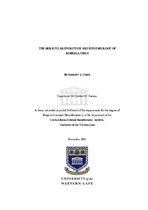| dc.description.abstract | Despite widespread rubella virus (RV) vaccination programs, annually RV still
causes severe congenital defects in an estimated 100,000 children globally. A
concerted attempt to eradicate RV is currently underway and analytical tools to
monitor the global decline of the last remaining RV lineages will be useful for
assessing the effectiveness of this endeavour. Importantly, RV evolves rapidly
enough that much of its epidemiological information might be inferable from RV
genomic sequence data.
Using BEASTv1.8.0, I analysed publically available RV sequence data to estimate
genome-wide and gene-specific nucleotide substitution rates, to test whether the
current estimates of RV substitution rates are representative of the entire RV genome.
During these investigations, I specifically accounted for possible confounders of
nucleotide substitution rate estimates, such as temporally biased sampling, sporadic
recombination, and natural selection favouring either increased or decreased genetic
diversity (estimated by the PARRIS and FUBAR methods) at nucleotide sites within
RV nucleic acid secondary structures (predicted by the NASP method).
I determined that RV nucleotide substitution rates range from 1.19×10-3
substitutions/site/year (in the E1 region) to 7.52×10-4 substitutions/site/year (in the
P150 region). I found that these differences between nucleotide substitution rate
estimates in various RV gene regions are largely attributable to temporal sampling
biases, such that datasets containing a higher proportion of recently sampled
sequences will tend to have inflated estimates of mean substitution rates. Although
there exists little evidence of positive selection or natural genetic recombination in RV, I revealed that RV genomes possess extensive biologically functional nucleic
acid secondary structures and that purifying selection acting to maintain these
structures contributes substantially to variations in estimated nucleotide substitution
rates across RV genomes.
Although both temporal sampling biases and purifying selection favouring the
conservation of RV nucleic acid secondary structures have an appreciable impact on
substitution rate estimates, I find that these biases do not preclude the use of RV
sequence data to date ancestral sequences and evaluate the associated RV
phylodynamics. The combination of uniformly high substitution rates across the RV
genome and strong temporal signal within the available sequence data enabled me to
analyse the epidemiological and demographical dynamics of this virus during these
attempts to eradicate it. By implementing a generalized linear model (GLM) and
symmetrical model of discretized phylogeographic spread, I was able to identify
several predictive variables of geographical RV spread and detect transmission
linkages between distinct geographical regions. These results suggest that, in addition
to strengthened vaccination strategies, there also needs to be an increased effort to
educate people about the effects of vaccination and risks of RV infection. | en_US |

